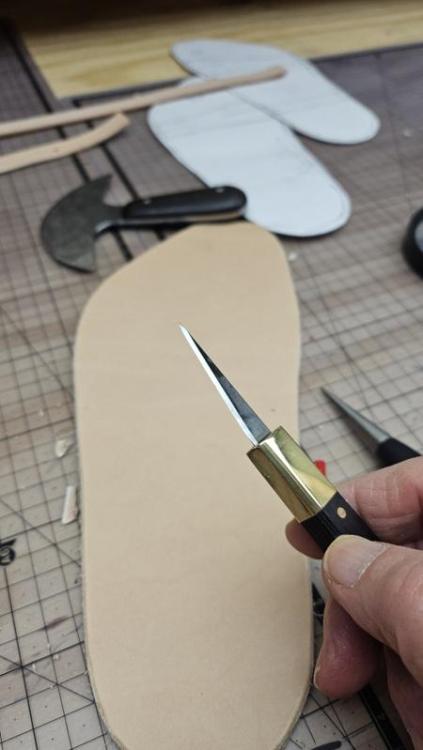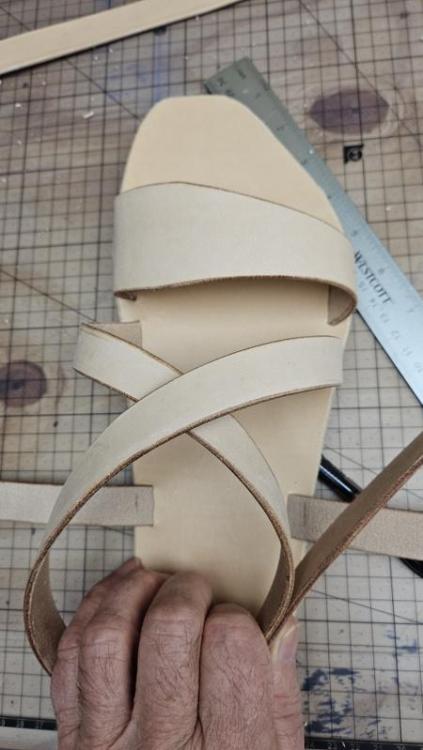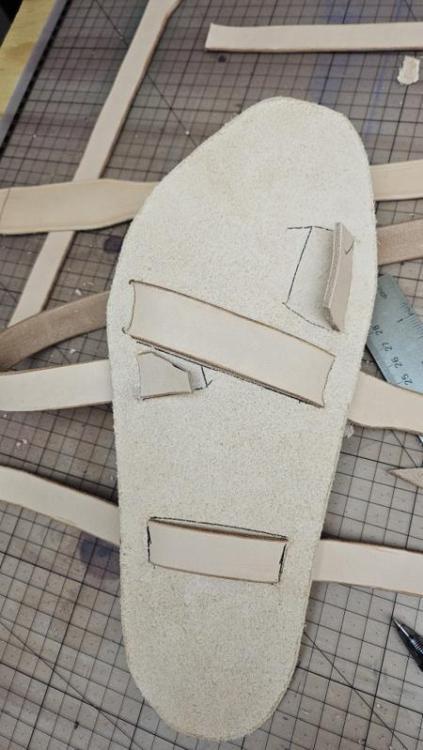
deboardp
Contributing Member-
Posts
189 -
Joined
-
Last visited
Content Type
Profiles
Forums
Events
Blogs
Gallery
Everything posted by deboardp
-
I had no idea there was a forum for sharpening knives. Thanks! I did decide to change the profile of the blade, make the angle less, and it might be futile. Ilk check out that forum, maybe there's some tips that will help. I'm careful about the burr. I do circles until a burr develops along the whole blade, then turn the blade over and sharpen until there's a burr, and repeat.
-
He greases his rifle? I bet he drops it all the time.
- 193 replies
-
- saddler recipe
- diy conditioner
- (and 4 more)
-
That is interesting. I didn't know tallow was used to lubricate steam engines. I don't actually know how a steam engine works, therefore don't know what are the parts that need lubrication. Did you know that tallow can have two sources within each animal? One is the fat under the skin or surrounding muscles, and the other is called leaf fat, and it surrounds the kidneys. Leaf fat has a different texture and color from body fat, and I think I read that it's chemical formula differs from that of body fat. My impression was that it's the best and most stable as tallow. But my memory fails me. I wonder why beef and sheep tallow doesn't stink after a while at room temperature. That's very interesting. I'm going to use some on my first pair of sandals, for my feet. I'll try the Colorado Leather Balm, which has tallow, Beeswax, lanolin, orange essential oil, and vanilla essential oil, all of them in unspecified quantities. It's a soft paste at my apartment's air temperature of 66-68F. I'll do the warm and wet method, massage into the leather as much of the goo that it will take. I hope it turns the leather a nice brown color. I'll show it off in the Show Off forum. Now that I have a knife that can clean out the corners of my slots, I can get back to work on my footwear.
- 193 replies
-
- saddler recipe
- diy conditioner
- (and 4 more)
-
-
-
-
The Tandy Pro Knife came this week and I was able to finish the corners of the slots on one top sole today. The blades that come with the knife are not very sharp and the steel is very hard, so I spent about a half hour with the coarse stone trying to make it sharp enough to cut leather with little back and forth motions. I managed with some difficulty to finish the task, but will definitely want that knife sharper for the second topsole. Notice the angles of the dead ends. They have to equal the angles on the other side of the leather sole.
-
Colorado uses essential oils of orange and vanilla. Thanks for this description of how you did it! I'll use it as a guide! Gotta go.
- 193 replies
-
- saddler recipe
- diy conditioner
- (and 4 more)
-
Got it. One part experience, 2 parts diddling, 3 parts fiddling. I'll play with it.
- 193 replies
-
- saddler recipe
- diy conditioner
- (and 4 more)
-
@fredk this is another thread I started that proves I have a shop. In my apartment. Hope that helps change your mind.
- 193 replies
-
- saddler recipe
- diy conditioner
- (and 4 more)
-
Can you tell me the exact amounts you used?
- 193 replies
-
- saddler recipe
- diy conditioner
- (and 4 more)
-
I'm a 77 year old man who is disabled by exposure to agent orange during my service in the Vietnam War. I lived on a base cleared with that herbicide from which we flew combat missions of fighter escort and EW escort for the B-52's. We also connected the Vietnam command to the US by phone and teletype. I worked with that crew, in the multiplexing center. I became disabled in 2004 by the developing illnesses caused by herbicide exposure. I had to stop working and was homeless for 15 of the past 18 years. I became housed in September of 2023 because i received a HUD-VASH voucher. In 2022, mainly due to Jon Stewart, the comedian and talk show host, the US Congress passed the Pact Act which says that soldiers such as myself no longer has to prove they were exposed to herbicide if they were at particular places at particular times. Jon had yelled at Congress, "SHAME ON YOU!!" More than once, for not granting us disabled veterans disability compensation. (It's usually not possible to prove exposure.) So in December 2023 I was granted disability compensation, just 30 days ago. My disease disabilities add up to 190% disability, but of course they round it off to 100%. Although i had the housing voucher, my SS retirement benefits were roughly $500 a month shy of covering all my expenses, so until 30 days ago I was facing homelessness again without that $500 additional income. I had started making this sandal shop in September 2022 because I used to make a good sandal 50 years ago, and I didn't think the VA would ever compensate me. But now I'm being compensated and will not become homeless again in my 80's. I joined this leatherworker.net group because of all the questions I had about leather working and I've gotten most of my answers. If folks think I'm a troll I can leave. @fredk and @SUP had jumped on me for being humble so I instinctively explained why I am humble, which is that I'm trying to act like a Christian. Maybe if they stop trying to tell me I'm wrong to be humble I wouldn't explain why I am. I don't know how that makes me a troll.
- 193 replies
-
- saddler recipe
- diy conditioner
- (and 4 more)
-
Nobody should respect me, and I certainly don't respect myself. I know myself. There's nothing good in me. That's called humility, a virtue. About getting stuff on the cheap, yes, I'm okay with that. That's why, if this Colorado Leather Balm works, I want to make my own, since I have 50 tins and lids. I'll give my customers a tin of it with each order.
- 193 replies
-
- saddler recipe
- diy conditioner
- (and 4 more)
-
The can says that this Colorado Leather balm goes liquid at 95F. That's like close to how warm a sandal will get with a foot in it. A bit more beeswax will raise the melting point.
- 193 replies
-
- saddler recipe
- diy conditioner
- (and 4 more)
-
Thanks for the warning about the wax. I'll reduce what I plan to use, maybe do 12.5% instead of 25% of the total weight. Lanolin smells great to me, too. It's a bit thin, not very pasty, although I haven't scooped any out of the bucket to work it with my hands. I'll know more when I pull the tallow and the lanolin out of their containers. I'll pinch a bit of each for a feel.
- 193 replies
-
- saddler recipe
- diy conditioner
- (and 4 more)
-
I do like the way folks did it before. If the tallow doesn't stink up the sandal, I will be okay with it. After all, beef sides used to have beef fat in them, under them, etc, so putting it back is not such a new thing for the sides. Petroleum jelly seems like a cheap new way, typical of our western cheap culture. And since I put some vaseline on my leather, I noticed they don't actually welcome it. It stays mostly on the surface. I know, I should warm-wet the leather and rub it in. Still seems quick and cheap. I have standards (nose held in the air, accompanied by a sniff).
- 193 replies
-
- saddler recipe
- diy conditioner
- (and 4 more)
-
I protest! I'm simply trying to find a grease recipe that will work for me! And apparently anything at all will work, but I want something that smells nice, makes the leather soft and supple, attractive, smells nice, and I have nothing else in the world to do, so there ya go. I do have problems, but they are not related to leather work. Brain damage is one. Hahaha. I got the Colorado Leather Balm today, and that stuff smells nice! Tallow, lanolin, beeswax, proportions unknown to me at this time. Probably on the MDS. It's not cheap! $30 for 8 ounces, plus tax and shipping. The instructions say just rub it in, no mention of warm water first. It smells sweet, too, and I looked to see if sugar was an ingredient. As for using petroleum jelly, I smeared some on a piece of veg tan, and it was absorbed partially, but the rest stayed on the surface for a week before I put the piece aside somewhere. I'm considering making my conditioner anyway, since I have everything. I wish I knew what ratios to use, for example for tallow, lanolin, and wax. Oz used 25% wax, 50% tallow, 25% lard. He said that's basically what the English saddlers have used for centuries. So if i did use tallow, it would be 25% wax, 50% tallow, and 25% lanolin. I could make a small batch. My tiny tools are due on Tuesday, for cutting the corners of my curved and sloped slots. Maybe I'll make a batch on Monday, like, 8 ounces. 2 oz wax. 4 oz tallow, 2 oz lanolin, put it to the schnoz. The tallows I have are different colors. I said this before. One is yellow and smells like hamburger run-off from cooking burgers. The other is pure white, creamy, very fine textured, and has almost no smell. When cold it has no smell that I could detect. On a warm heated sandal, I wonder. I guess I will find out. I'm going to use the Colorado Leather Balm on the first pair I make, for my grossly large feet, swollen from my various diseases. I'll report about aroma when the sandal has been worn and is warm.
- 193 replies
-
- saddler recipe
- diy conditioner
- (and 4 more)
-
OK, have fun storming the castle. Let us know what you decide to use and how it turns out for you. Best wishes with the sandals. Will do, of course! Thanks for your best wishes!
- 193 replies
-
- saddler recipe
- diy conditioner
- (and 4 more)
-
You're funny. Like I said, I'm not interested in oiling my leather. I'm making grease. I don't need to reference your formula for ratios of oils, because I'm not using oils. I think it's you that is not understanding, Scott.
- 193 replies
-
- saddler recipe
- diy conditioner
- (and 4 more)
-
I thought the old guys used grease, you know, tallow and lard, not oil? Maybe it was just the English...
- 193 replies
-
- saddler recipe
- diy conditioner
- (and 4 more)
-
Yes, they are heavy with oil. Saying they are not, that they are recipes with oil in them, does not make them not heavy with oil. If I recall correctly, one of your first recipes had two full 16oz bottles of oil in it! Your conditioner is not a grease but is an oil. I had considered using an oil in my grease if the grease was too thick, but I thought maybe a tablespoon or two in an 8 ounce portion of grease. I'm not going to oil my leather, I'm going to warm-and-wet stuff it with grease.
- 193 replies
-
- saddler recipe
- diy conditioner
- (and 4 more)
-
I should have said I can smell the animal meat. Lanolin does smell stronger but it's not a meat smell and it is positively a pleasant smell. In deference to the monks who do not eat meat ever, and to vegans, vegetarians, and my sensitive olfactory function I'll walk the narrower path.
- 193 replies
-
- saddler recipe
- diy conditioner
- (and 4 more)
-
I don't have any experience making conditioner. 50 years ago in my first shops i used a little pure neatsfoot oil and never gave conditioning a thought. Today, I want to be sure my sandals last at least 2-3 decades. When I started looking for the best conditioner for the leather I use - vegetable tanned leather - I came across the conditioner formula that English saddlers have been using allegedly for centuries, and read that it had no oil whatever in it. It had two kinds of saturated fat - tallow and lard - beeswax, and lanolin. It was heated, stirred, put in tins where it cooled. It was a thick grease. So your recipes are heavy with oil and that's why I'm not interested in them. You also mentioned using the orange oil as a solvent to help work the conditioner into the fibers of the leather and if I recall you mentioned that there are other solvents. The most common solvent in chemistry is water, and its ability to dissolve is enhanced by heat. When the English Saddlers use their saddle grease they used warm water to wet the leather and let it work for a period of time, I believe it was just a few minutes. Vegetable tanned leather, having had everything but its collagen fibers removed during tanning, soaks up this warm water. It's pores open. When the absorption and opening is complete, the saddler uses his bare hands and massages the grease into the open pores of the leather, grain side, flesh side, and the edges. The rubbing and massaging creates heat, which makes the grease more fluid, and able to penetrate into the open poresWhen it seems the leather is well greased through and through, the saddle is put aside for three days so it can dry. When the water has evaporated out the pores and the leather is dry, the saddler rubs the leather with a cloth to remove surface residue. Then putting a small amount of cod liver oil on his cloth, he puts a shine on the leather. This cod liver oil is not a conditioner and it is not absorbed by the leather, because the leather is already stuffed with tallow, lard, wax, and lanolin. So the leather has no oil at all in it, none at all. I had only considered using oil as a thinner, but after revisiting the above, I'm inclined to forget about using any oil at all in my conditioner, making my own version of leather grease instead. As @chuck123wapati said, in his usual brilliant manner, why use a degreaser in your grease? It just doesn't make sense. @SUP agrees. As do I, obviously. Chuck is a great resource. The only difference? I'm leaning toward a grease formula that doesn't include tallow and lard. Since I can smell the animal in both those products, I prefer to not use them. I prefer things that have a decidedly strong pleasant smell, like the beeswax and the Lanolin. I'll think about using coconut oil rather than the fish oil for the shine. That might help the coconut smell be prominent. We'll see. Now that the ruminant is out, I'll continue to ruminate the shine. Feedback is welcome from all.
- 193 replies
-
- saddler recipe
- diy conditioner
- (and 4 more)
-
Exactly!
- 193 replies
-
- saddler recipe
- diy conditioner
- (and 4 more)
-
Instinctively, I am concerned about this product. It's a solvent that puts off heat as it evaporates. It can irritate the skin. If it evaporates it will no longer be in the leather. If I use an oil, I want it to stay in the leather so that the grease (my conditioner) will stay soft and not become cake. My leather will be in contact with skin, or separated only by the thickness of a sock, so for all those reasons I won't use it. Scott why do you buy so much of this orange oil in its various forms? What do you do with it? And why are you making so many batches of conditioner? What do you do with all those jars and tins of conditioners? From what you have written I get the impression that you have made quite a bit of conditioner in a number of configurations. Why? Just curious. What do think of coconut oil as an ingredient? Do you have any experience with it? I think that it would be a pleasant aromatic addition to my formula. Do you know what makes an oil go rancid? Is it the presence of unsaturated molecules in it? My friend and I thought that coconut oil would be stable long term because it is saturated.
- 193 replies
-
- saddler recipe
- diy conditioner
- (and 4 more)





